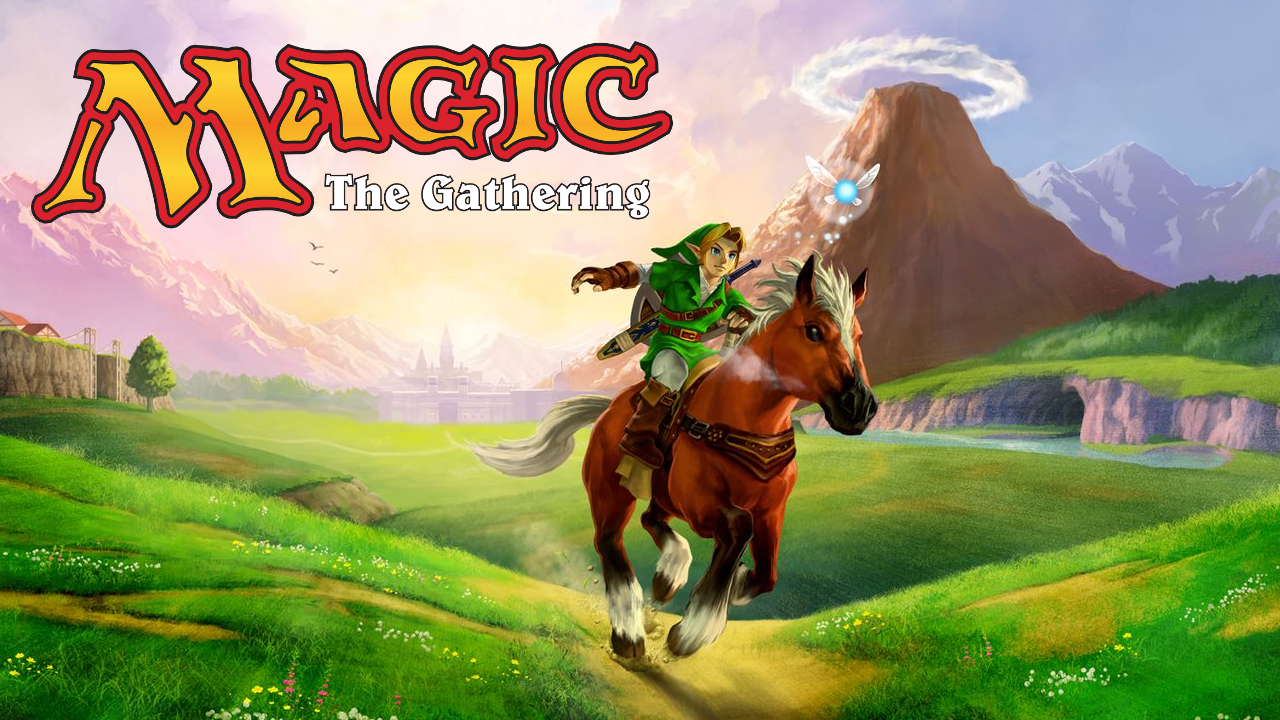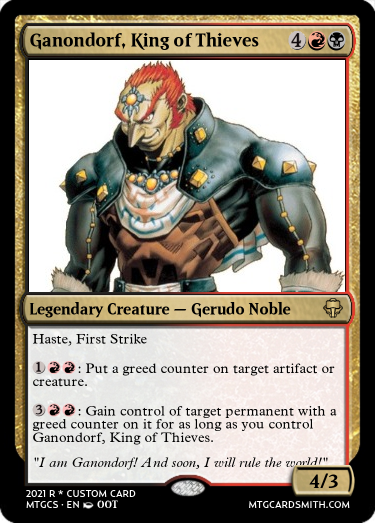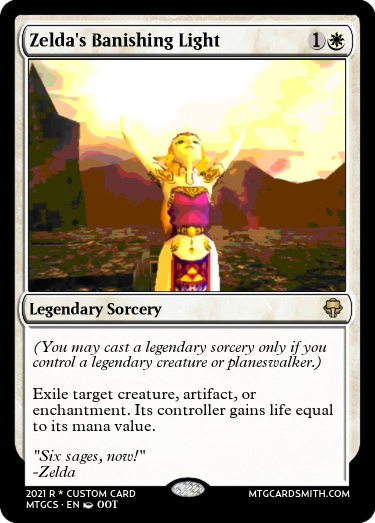What If: Magic: The Gathering Crossed Over With The Legend of Zelda Series
Posted on June 25 2022 by Sean Gadus

Magic: The Gathering is one of the most popular games in the world. The long-running table-top card game, which started in 1993, has a huge global community that show out for every new expansion and product launch. One of the beauties of MTG lies is the game’s flexibility. With almost thirty years worth of cards, players can build decks based around any number of ideas and themes. This makes deck-making a manifestation of a player’s personality, playstyles, and interests. Players can build decks with one of the five colors of Magic (White, Blue, Black, Red, and Green) or build a deck that experiments with different color combinations. Players can build decks based around specific creature types (Elves, Goblins, Knights, and Dragon), or they can build decks around their favorite in-game mechanics and strategies.
For as long as I’ve played Magic (which is most of my life), I’ve always wondered what Zelda-themed Magic: The Gathering cards would look like. While the idea of a Zelda-themed set seemed absolutely impossible in 2001 when my brother was teaching me how to play Magic, Magic‘s parent company Wizards of the Coast has opened a window that makes it possible for something like Zelda-themed card to be a reality in the future. Using a product brand called Secret Lair, Magic has experimented with crossovers with series like The Walking Dead (to much controversy), Stranger Things, Street Fighter, Arcane: League of Legends, and Warhammer 40,000. Most significantly, Wizards of the Coast will publish a full Magic: The Gathering set based on The Lord of the Rings mythology in 2023.
While Magic players can debate the motives behind these crossovers, as well as their fit within the extremely well-established Magic universe, many of these crossovers are exciting for fans of the above-mentioned properties. With this in mind, this article will explore what some new cards from a Zelda-themed set could look and play like. For this article, I will be focusing exclusively on cards based on Ocarina of Time, my favorite Zelda game of all time. I also will not be creating any new mechanics for my Zelda-themed cards; instead, I am using existing mechanics and abilities from Magic: The Gathering sets. I have divided the article into two explanations, one for a reader who might not be familiar with the details of Magic: The Gathering (who might just want to browse the pictures), and another explanation for Magic players who know the game’s mechanics more closely. Regardless, I hope you enjoy my vision for a Magic: The Gathering and Zelda crossover!
Note: All cards were created on the website MTG Cardsmith, and any similarities to other fan-made cards are coincidental.
Lands/Locations
For Beginners
Overall, Magic: The Gathering is known for its cycles of lands. Land cycles often contain five total cards, with each one associated with one of the five colors found within the game. Lands are a building block of the game, so every deck will include some combination of lands in them. A standard sixty-card Magic deck usually has between 20 and 25 lands in it.
If there is a cycle of lands, these lands usually share a design theme or structure. In Ocarina of Time, there are plenty of iconic locations to choose from when designing a five-card cycle of lands. For this initial set of lands, I chose five locations that Link can visit as a child. I felt that these five locations match some of the themes and core elements of the five colors of Magic.
For Magic Players
Iconic land cycles are nothing new to Magic: The Gathering. I was primarily inspired by the five Champions of Kamigawa lands, along with the ten-land cycle seen across the Innistrad block. Each of the lands in my cycle give colorless mana, as well as having a secondary three-mana ability associated with a single color.
Kokiri Forest is the first location in the story, and this is where Link is sheltered from the dangers of the outside world. Hexproof allows a creature to be protected from most spells trying to destroy it, so Kokiri Forest can give a creature a small boost and protection from an opponent’s spells. Next, there is Hyrule Field, the first location outside of the Forest. This is Link’s first step outside his quiet home, and an early proving ground for the young character. Hyrule Field gives a creature First Strike, which is a useful ability in combat. Originally I thought that Life Gain would be a good mechanic for a white-themed land, but the ability did not fit with Hyrule Field, and I wanted to highlight one of the game’s most iconic locations.
Kakariko Graveyard was easy to create because of the location’s strong connection to death and decay. The card allows the player to return creatures from their graveyard to their hand. Reanimating and returning dead creatures to the player’s hand is a key ability for Black creatures and spells. This ability is seen on powerful Magic lands like Volrath’s Stronghold and Unholy Grotto, though the ability on Kakariko Graveyard costs more mana than the abilities on both of those cards. For Death Mountain, I tried to find a mechanic that represented the unstable eruptions that Link encounters near the peak of the mountain. I used a standard Red ability that damages every creature and player (similar to the ability seen on the cards Pyroclasm or Inferno). Death Mountain Summit can help clear threats off the board quickly if a player has small creatures, or it can help the player damage an opponent if they are close to finishing them off. Lastly, there is Lake Hylia. I struggled with the mechanic on this land. Ultimately, I decided that untapping a creature was the most interesting ability that Blue had to offer without making the land too complicated. Lake Hylia was partially inspired by the design of the iconic land Minamo, School at Water’s Edge from the expansion Champions of Kamigawa.
Childhood
For Beginners
When making this set, my goal was to make three versions of the iconic trio of Link, Zelda, and Ganondorf. One set of cards would represent childhood, one set of cards would represent adulthood, and one set of cards would show the characters near the end of the game. This first set of cards represent the characters prior to Link lifting the Master Sword from its pedestal.
Overall, Link’s color identity was very easy to figure out as Link fits very well within the color Green. Like many elves from Magic: The Gathering, who are associated with Green, the Kokiri are tree dwelling creatures with strong connection to nature. In essence, the Kokiri share many of the qualities that elves are known for in the Magic: The Gathering. Since this is the first version of Link, I also designed Link’s first card as a small creature, but he gets strong every time he attacks. This fit the story well as Link grows as he overcomes the early dungeons and bosses.
For Zelda, I chose a card that fit her role as an advisor rather than a fighter. Zelda’s abilities help give the player an advantage through Gain Life and drawing cards, and she can also boost other creatures that the player controls. Card advantage is one way to get ahead of an opponent and control a game. Finally, for Ganondorf’s first card I focused on his identity as a thief. Ganondorf is referred to as “the King of Thieves” during this section of the game. This card can steal an opponent’s creatures and artifacts, which can help swing the game in your favor. This is a classic ability associated with color Red in Magic: The Gathering.
For Magic Players
Link has a strong connection to Kokiri Forest, and it was a perfect fit to make Link a Green creature. Link is even referred to as “the boy from the forest” at one point in the game. For this card, I wanted a mechanic that would connect to Link’s growth as a young hero, so I chose a recurring combat ability that made him stronger every time he attacked (+1/+1 counters). While he starts out small, Link can get stronger quickly. I also made Link, Child of the Forest uncounterable, which is a powerful Green ability seen on legends like Thrun.
Zelda’s design was a mix of two key mechanics: Card Draw and Life Gain. Card Draw is a Blue mechanic and Lifelink is a White mechanic, so Zelda ended up as a White Blue creature. While Zelda is not a physical force herself, her abilities can be extremely powerful, and these abilities can give the player a huge advantage over their opponents. Befitting her role as a planner and strategist, Zelda can also “influence” other creatures by giving them Lifelink, which feeds back into her first ability of drawing cards when the player gains life. Due to the power of her first two abilities, I made Zelda a small creature, which makes her vulnerable to a variety of spells and abilities that opponents might have.
Since Ganondorf is the villain of the game, I chose to make him a Red Black creature. I focused on the character’s role as a thief. Red has a long association with stealing permanents from other players (the “threaten” mechanic). I took heavy inspiration from Olivia Voldaren, an iconic vampire legend that allows its controller to steal other people’s creatures for as long as they control Olivia. The greed counter was a simply way of illustrating the character’s covetous nature. Ganondorf is always aggressively pursuing his goal of sowing discord, so I gave him Haste as well.
Adulthood
For Beginners
This second set of cards focuses on the characters after Link lifts the Master Sword from its pedestal. Link’s card is White Green because I want to highlight his role as a hero. He also has classic abilities seen on knight creatures from Magic: The Gathering. Sheik is one of my favorite characters in the series, so I wanted to make sure I highlighted Zelda’s disguise in this section of the game. Since Sheik is the character who explains how to travel back in time to Link, I gave her card a focus on time. Getting extra turns and manipulating time is one of the most powerful Blue abilities in Magic, so I also made Sheik relatively weak so that it was not too unfair. For Ganondorf, his card focuses on his role as a magic user, and he has two built-in abilities that can be activated any time you have him out.
For Magic Players
Link’s second card was inspired by classic knight cards and the popular card Eternal Witness. Link’s return signals a renewal of hope for Hyrule, and the closest ability that fit this idea was to return a lost card from your graveyard to your hand. This is an underrated ability that can be very powerful depending on what you have in your graveyard. I also gave him two classic White abilities (First Strike and Lifelink) which appear on many knights and other White creatures.
Sheik’s design took a long time to create. There are ninja-themed cards in Magic, but the ability connected to Ninjas (Ninjitsu) is a bit complicated. Instead, I settled on exploring Sheik’s connection to time. One of Sheik’s roles in the story is explaining time travel to Link in the Temple of Time (after completing the Forest Temple). Sheik’s card has the ability to give the player another turn for six mana, as long as she deals damage. Getting another turn is the most powerful Blue mechanic in the game, and it can be devastating. Once a player uses Sheik’s ability, the card is shuffled back into the deck, so the player cannot use it over and over again. As a character who has avoided being captured by Ganon for years, I felt that the card needed some type of evasion to represent that. Hexproof proved to be too unfair given the nature of her second ability, but Unblockable felt more fair. Players can still remove Sheik with a variety of kill spells or direct damage, but she can avoid creatures in combat.
For Ganondorf’s second iteration, I wanted to focus on his powers as a spellcaster. His second card had to have flying since he floats over Link during their energy ball tennis match. The first ability allows him to negatively affect an opponent, while the second is beneficial to his controller. His first ability was inspired by cards like Blightning and Kroxa, Titan of Death’s Hunger; both cards strip opponent of life and cards in their hand. The second ability is a classic Blue Red draw spell, with the player drawing two cards and then discarding one. Though both abilities are not cheap to use, sinking a lot of resources into these abilities could be devastating.
Finale Versions
For Beginners
The Finale version of these characters represent the last section of the game from when Link returns to the Temple of Time after completing the Spirit Temple to the conclusion of the game. These are the most powerful versions of the characters, and thus the most powerful cards.
Link, Hero of Time is all five colors, due to the fact that Link has conquered all the temples and obtained all the Medallions. This final version of Link has one ability for each color of Magic. Zelda’s design was based on two strong abilities that have an immediate impact on the game. Given her role in guiding Link throughout his journey, I felt that allowing her to get another legendary card out of the deck worked very well. If you have this card, you can search for Link, Hero of Time! My main goal for Ganon was creating a card that was very powerful, but also a bit reckless. In order to play Ganon, the player must either lose life or reduce their own life total. And once Ganon gets on the field, he is a threat that can end the game.
For Magic Players
It was difficult for me to identify what Link’s final form would look like until I thought about the temples and Medallions. The Medallions are given out as symbols of the trials that Link has gone through in the second half of the game. Having completed all of the temples, it feels like Link has conquered all of the elements, hence his status as a WUBRG (the informal name for being all five colors). While Link, Hero of Time is difficult to cast, he is extremely powerful. I gave Link an ability for every color, similar to the real MTG card Chromanticore. This is the “ultimate warrior” version of Link, with the hero being at the peak of his skills and powers.
Princess Zelda’s design combines two strong abilities that can make a large impact on the game. First, given her role in guiding Link throughout his journey, I felt that allowing her to get another legendary card out of the deck worked very well. If you have this version of Zelda, you can also search for Link, Hero of Time. This ability was inspired by Captain Sisay and Thalia’s Lancer. Her second ability allows the player to stock up on cards if an opponent is targeting their creatures. The ability to draw cards and replace creatures you might be losing is very powerful, but it also makes Zelda, The Seventh Sage a target for removal.
Ganon was actually the first card designed for this article, and one of the original inspirations for this “What If” activity. I knew from the beginning I wanted Ganon to be very powerful, and I wanted Life Loss to be incorporated in some way. By the end of Ocarina of Time, Ganondorf has been consumed by his hate for Link and Zelda to the point he is willing sacrifices his humanity in an attempt to destroy them. The enraged, painful scream that emerges as he transforms is one of my favorite villain moments in the Zelda series. I added the additional cost that you have to lose life to cast it, which fits the character well. Overall, Ganon is extremely powerful. It has Haste, Trample, and a high power and toughness (7/7). If left unchecked, this card is a game ender. I also incorporated the ability to draw cards at the cost of life, which is a classic Black ability (and one of my all time favorite abilities).
Legendary Spells
For Beginners
Legendary spells are a relatively new mechanic in Magic, debuting in 2018. I created one legendary sorcery for each bearer of the Triforce. This was a fun way to showcase key story events like Link’s arrival in Ganon’s chambers, Link’s final attack against Ganon, and Ganon’s banishment by Zelda and the Sages. These powerful cards require the player to have a card that is a “Legend” on the field in order for it to be played (basically a Named character from across the Magic universe).
For Magic Players
I created one legendary sorcery for each bearer of the Triforce. These cards require the player to have legendary creature on the battlefield, so they have an additional condition that must be met before you can cast them.
For Ganon, I created a legendary sorcery called Diabolic Convergence, which is a fun twist on the classic tutor. Black is known for its ability to look for any card in your library (Tutor) and put it into your hand. For Diabolic Convergence, each legendary permanent you control will reduce the cost of the spell. Having at least three legendaries on your side of the field transforms the card into the classic Demonic Tutor. Demonic Tutor is one of the most iconic cards from Magic, and it was printed in the first ever Magic set (Alpha).
For Link, I chose to focus on Link’s final blow to Ganon. Link’s Final Blow will instantly make a creature massive by boosting it +5/+5. Additionally, the secondary ability allows a legendary creature to potentially eliminate a creature threat on the board with its fight ability. Finally, Zelda’s Banishing Light allows the player to exile a variety of permanents with a small draw back. This was inspired by cards like Swords To Plowshare, Path To Exile, and the recent Fateful Absence. This card represents the moment when Zelda and the Sages banish Ganon to the Sacred Realm, trapping him for a generation.
Conclusion

Magic: The Gathering is one of the most popular games in the world, with millions of active players. As a Zelda and Magic fan, I would love to see a crossover between the two. For any Magic fans on the site, I hope that my article stoked your interested in what a Zelda-themed set could look like. Who knows what the future holds, and there is a chance that one day my dream will be a reality.
If you did not enjoy the idea of Zelda and Magic crossing over, please be polite in the comments. This article was made in good faith towards the entire Zelda community. But if the idea of a Zelda-Magic crossover intrigued you, be sure to tell what you’d want to see in the comments below.

Sean Gadus is a Senior Editor at Zelda Dungeon. His first Zelda game was Ocarina of Time, and he loves all of the 3D Zelda games from 1998-2011. The final battle of Tears of the Kingdom is one of his favorite final battles in the entire series. He wants to help build a kinder, more compassionate world. You can check out his other written work at The-Artifice.com.




















